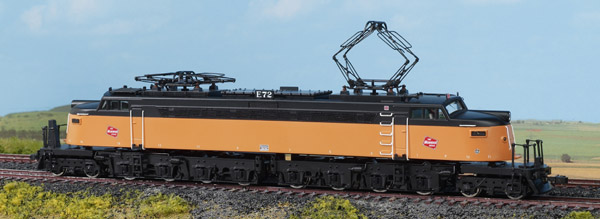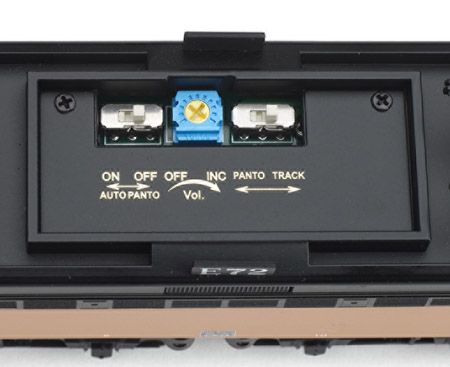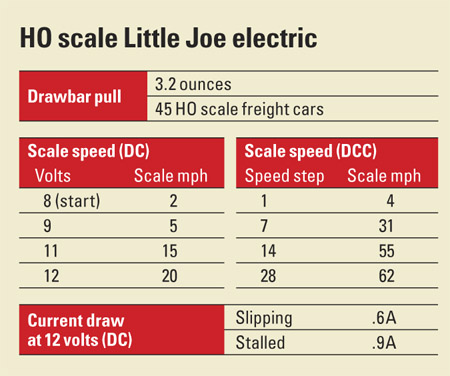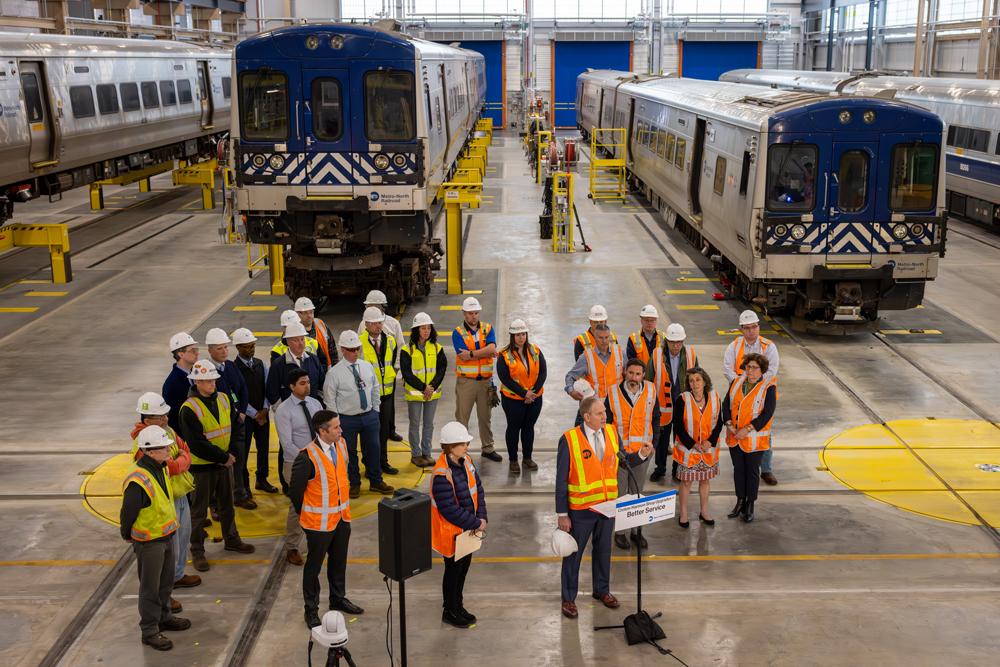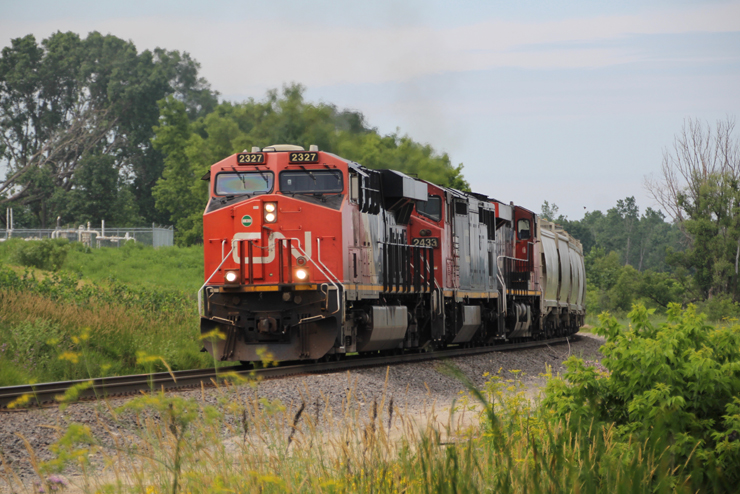The model includes the MTH Digital Command System, which is a proprietary command control system, and it operates on MTH DCS, Digital Command Control (DCC), and DC layouts.
The prototype. At the end of World War II General Electric built a fleet of dual-cab 5,500 hp electric locomotives under contract for the Soviet Ry.’s five-foot gauge track. By 1948, a Cold War ban nullified the sale and GE was stuck with the locomotives.
At the outset of the Korean War in 1950, the power-starved Milwaukee Road purchased 12 of the locomotives and converted them to standard 4′-81⁄2″ gauge. The locomotives served on the Milwaukee Road’s electrified Rocky Mountain Division. The railroad designated 10 locomotives for freight service (class EF-4) and two for passenger service (class EP-4). The nickname for both classes, “Little Joe,” referred to the locomotive’s original destination of Joseph Stalin’s Soviet Union.
Three identical locomotives hauled freight on the Chicago, South Shore & South Bend, and five others worked on Brazilian railroads.
In 1974 the Milwaukee dieselized its electrified lines and scrapped all but one of its Little Joes. Milwaukee Road E70 remains as a museum display. The locomotive’s sisters on the South Shore ran until 1983, and those in Brazil until 1999.
The major dimensions of the model match drawings in the August 1956 Model Railroader. The only major deviation from these drawings is that the shanks of the remote-control couplers on the model are a scale foot too long.
The model. Our review sample has a die-cast metal body shell accurately painted in the Milwaukee Road’s freight scheme. There’s sharp color separation between the black and orange paint. Small printing, such as the Milwaukee Road heralds and the journal numbers along the sill, are crisp. There’s also a General Electric builder’s plate printed on each side of the body.
The placement of detail parts matches prototype photos. Handrails, hand grabs, piping, and other details are separate plastic parts. The metal air horns are separately applied.
The interior of the model is packed with the flywheel-equipped motor, electronics, and two downward-facing speakers mounted on the metal chassis. All eight driver axles are powered.
The prototype Little Joe had two four-axle motor frames hinged in the middle with two pivoting trucks at each end. On the model the die-cast metal pilot platforms have pivoting trucks beneath them. The driver axles are mounted on two separate assemblies that pivot between the second and third axles and sixth and seventh axles.
The model can negotiate 18″-radius curves but looks better on curves of 22″ radius or greater.
Operating pans and couplers. The most interesting feature on the MTH Little Joe is the raising and lowering of the pantographs in DC, DCC, and DCS operation. When you first unpack the model, it’s important to read the instructions and remove the locking latch from each pantograph before putting the Little Joe on the track.
On DC layouts the pantographs raise and lower automatically according to the model’s direction. Following the Milwaukee prototype, the leading pantograph is up and the trailing pantograph is down when the locomotive is forward. When the direction switch is flipped the trailing pantograph comes up, then the leading pantograph lowers. This models the prototype where one pantograph always must be in contact with the catenary for the locomotive to receive power.
Using a DCC or MTH DCS system, you can use function keys to turn off the automatic operation as well as raise and lower the pantographs independent of the locomotive’s direction.
On DCC and DCS layouts you can open the locomotive’s front and rear couplers remotely, including sound effects. The tension of the knuckle springs on the remote-opening couplers is higher than that of typical magnetic knuckle couplers. The locomotive had to be moving at a 30 scale mph for its couplers to engage the coupler of an adjacent car and close the knuckles.
Two Kadee-compatible magnetic knuckle couplers and installation instructions are included.
The model ran well using an NCE Powercab DCC system and an MTH DCS Commander. When I set the DCC system to 128 speed steps, the Little Joe moved at 1 scale mph in speed step 1. Using DCS, the model accelerated smoothly in 1 scale mph increments. In both DCC and DCS, the model reached a top speed of 62 scale mph.
Sounds and programming. When I ran the Little Joe on DC, sounds were automatic. Effects included the blower and random air releases. The model emitted a squealing brake sound when I rapidly decreased the throttle.
There are more user-triggered sound effects when running the Little Joe with a DCC or DCS system. You’ll need a DCS or 28-function DCC throttle to use them all. Along with the bell and horn, there are forward, reverse, and grade-crossing horn signals. Function 4 on a DCC throttle and the PFA (passenger/freight announcements) button on a DCS system trigger a four-part sequence that includes crew dialogue. Another command triggers the sound of slack being pulled out of the couplers.
On DCC layouts the MTH model supports programming only on the main. The locomotive has 10 programmable configuration variables (CVs). Seven CVs provide options for programming the short and long address of the locomotive. You can also use CV55 to reset the model to factory defaults.
The remaining CVs control acceleration (CV3) and deceleration (CV4). For testing purposes I wanted the model to start and stop on a dime, so I set these CVs to their maximum value of 25. This is opposite of DCC decoders where a value of zero would equal no delay. It would be useful to have more CVs supported by the DCS system.
The MTH Little Joe has some DCC programming limitations, but its innovative features, such as remote control pantographs and couplers, make it a noteworthy HO scale model.
Manufacturer
MTH Electric Trains
7020 Columbia Gateway Dr.
Columbia, MD 221046-1532
www.mthhotrains.com
Road names: Milwaukee Road (freight scheme, nos. E72 and E75); Chicago, South Shore & South Bend (nos. 801, 802, and 803); Milwaukee Road (passenger scheme, nos. E20 and E21); Ferrovias Paulista S.A. (nos. 6451, 6452, and 6455); General Electric demonstrator
Era: 1948 to 1999
Features
- Electrical pickup on all 16 drivers
- Five-pole skew-wound motor with brass flywheel
- Metal RP-25 contour wheels in gauge
- Minimum radius: 18″
- MTH Digital Command System with Proto-Sound 3.0 operates on DC, DCC, and DCS layouts
- Optional user-installed driver set with traction tires
- Remote control pantographs
- Two remote-opening knuckle couplers at the correct height
- User-installed Kadee-compatible magnetic knuckle couplers
- Weight: 1 pound 8 ounces





